Markets
GameStop Meme Stock Craze Prompted Market ‘Plumbing’ Changes, Says SEC Chair Gensler
Published
1 month agoon
By
admin

GameStop’s short squeeze in 2021 taught the Securities and Exchange Commission (SEC) several key lessons. Among those highlighted in a Monday speech by SEC Chair Gary Gensler was the need to modernize equity markets, in part by embracing shorter settlement times.
A retail-led movement to bet big against Wall Street short sellers caused GameStop’s stock price to spike nearly four years ago amid the “meme stock” craze. Forced to hold or sell shares skyrocketing in price, restrictions imposed by several brokerage firms blunted the rally that was later enshrined in stock market history and recounted in books and films.
Gensler, an unwavering critic of the digital assets industry, partly pinned the restrictions on a lack of market efficiency. Ultimately, a shift toward shorter settlement times—that experts say blockchains benefit from—improved upon mechanics that stifled some GameStop investors.
“Many everyday investors lost access to the market at a critical time,” Gensler said. “The longer it takes for a trade to settle—the slower the plumbing—the more risk our markets assume.”
When purchasing or selling a stock on a venue like the New York Stock Exchange, there is a delay between when the transaction is made and when it becomes fully processed across a series of intermediaries, including a broker-dealer, clearing agency, and exchange.
Notably, the SEC has accused crypto exchanges like Binance and Coinbase of fulfilling several of these roles at once, without proper registration, while facilitating securities transactions. Both companies have denied the regulator’s claims amid ongoing battles in federal courts.
Once conducted through paper checks and physical certificates, the settlement window for securities has been shortened with SEC rule changes over time. Commonly referred to as T+2, a two-day settlement window was reduced in May, making what Gensler said was “a real difference” for everyday investors.
At the same time, the shift to T+1 influenced the relationship between brokers, which match buyers and sellers, and clearinghouses that facilitate the exchange of securities and payments.
Margin calls from clearinghouses led some brokers to restrict purchases of GameStop stock during its famed short squeeze in 2021. But the “amount of margin, or collateral, that must be placed with the clearinghouse” was reduced significantly with T+1’s adoption, Gensler said.
Gensler’s GameStop reflection followed crypto-focused remarks from Federal Reserve Governor Christopher Waller last week. Discussing the merits of decentralized finance (DeFi), he described how intermediaries have historically provided value—but now face competition.
As reflected in the popularity of centralized crypto exchanges, Waller posited that DeFi could play a complementary role to existing financial markets, rather than replace legacy systems. Along those lines, he said distributed ledger technology (DLT) like blockchain could be an “efficient and faster way to do recordkeeping,” while smart contracts flatten trade structures.
“Smart contracts can effectively combine multiple legs of a transaction into a single unified act,” Waller said. “This can provide value, as it can mitigate risks associated with settlement.”
Companies like tZERO are building blockchain-based marketplaces for private securities. The Utah-based firm gained approval from the SEC and Financial Industry Regulatory Authority (FINRA) to operate as a custodian for digital assets sold as securities last month.
In early 2025, the firm plans to launch with a “full digitization” of its Series-A preferred equity. But Wall Street tastemakers have visions for a crypto-based market extending far beyond that.
BlackRock CEO Larry Fink hailed tokenization as the “next generation for securities” in 2022. Using a digital representation of an asset to conduct trades on a blockchain, he said the process would provide market participants with “instantaneous settlement” and “reduced fees.”
Alongside the crypto’s rise, financial firms have looked at other qualities inherent to blockchains, such as the 24/7 schedule that they operate under within the context of trading. Crypto markets don’t close, which can provide both opportunities and risks alike.
In April, the Financial Times reported that the New York Stock Exchange was exploring round-the-clock trading. The development would be a significant break from the exchange’s regular six-and-a-half hour trading window, extended as recently as 1985.
Edited by Andrew Hayward
Daily Debrief Newsletter
Start every day with the top news stories right now, plus original features, a podcast, videos and more.
Source link
You may like
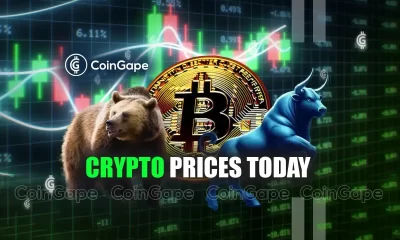

BTC and Major Altcoins Pullback, SAND Soars 60%


Трамп обирає менеджера прокрипто-хедж-фонду Скотта Бессента на посаду міністра фінансів


Trump calls up crypto pals, Senator says sell gold for Bitcoin | Weekly Recap


Where to Invest in November End?


XRP Price Hits 3-Year High At $1.6


Australia seeking advice on crypto taxation to OECD
Dogecoin
Dogecoin Jumps to 3-Year High Price—Before Bitcoin Cools and Meme Coins Plunge
Published
13 hours agoon
November 24, 2024By
admin

Dogecoin got another leg up late Friday and into early Saturday, climbing to a price point not seen in over three years. But it has since fallen, with DOGE and other top meme coins among the biggest losers of the last 24 hours.
DOGE popped above the $0.475 mark on Saturday morning—the first time that the meme coin had risen that high since May 2021. Dogecoin has been on a torrid surge in recent weeks, starting before the election and becoming substantially more explosive in the days after.
Previously, in terms of recent moves, DOGE had previously popped as high as nearly $0.43 on November 13; at the time, it was a three-year high mark, but that local peak has since been topped. DOGE is now up 195% over the last 30 days, and 430% over the past year, per data from CoinGecko.
It was a short-lived peak, however, as is typical for such a volatile coin. DOGE is now down to about $0.41 as of this writing as the broader crypto market cools after last week’s surge. Bitcoin, for example, has now dipped to a price of $96,725 after setting a new all-time high price of $99,645 on Friday and coming close to the $100,000 milestone mark.
Dogecoin is now down 12% over the past 24 hours, though it’s not the biggest loser from the top 10 cryptocurrencies by market cap: XRP has dipped by 14% during the same span after pushing to its own three-year-high mark on Friday.
Zooming out, however, it is mostly meme coins that have fallen the hardest out of the top 100 coins over the past 24 hours. Brett (BRETT), Bonk (BONK), Popcat (POPCAT), Dogwifhat (WIF), Pepe (PEPE), and Floki (FLOKI) have all fallen by 10% or more during that span, alongside Dogecoin. Broadly, the crypto market is down by nearly 5% over the past day.
Daily Debrief Newsletter
Start every day with the top news stories right now, plus original features, a podcast, videos and more.
Source link
Dogecoin
Elon Musk Tweet of Joe Rogan Profile Sends DOGE Price Higher
Published
17 hours agoon
November 24, 2024By
admin

Some crypto enthusiasts speculate that the service, once live, might include transactions with some digital assets such as DOGE, given Musk’s long-standing affection for the token. Musk’s electric car company, Tesla, already accepts DOGE payments for some merchandise purchases in its online store.
Source link
Bitcoin Magazine Pro
On-Chain Data Shows The Bitcoin Price Bull Run is Far From Over
Published
2 days agoon
November 23, 2024By
admin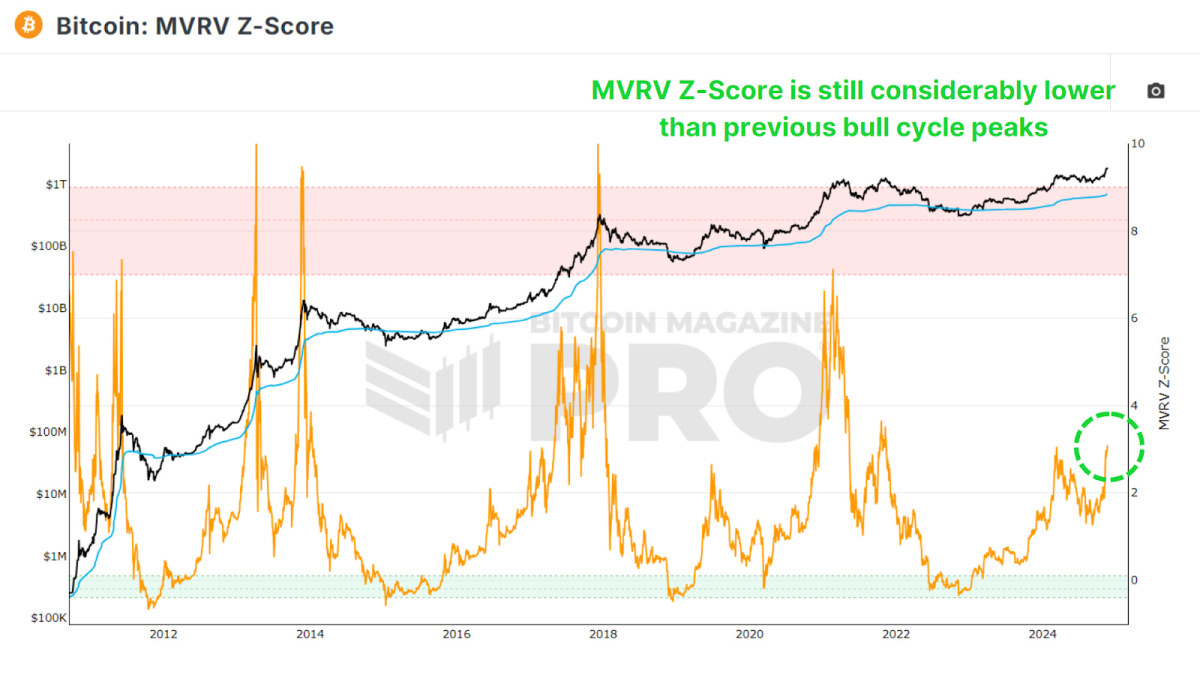
Bitcoin’s recent price action has been nothing short of exhilarating, but beyond the market buzz lies a wealth of on-chain data offering deeper insights. By analyzing metrics that gauge network activity, investor sentiment, and the BTC market cycles, we can gain a clearer picture of Bitcoin’s current position and potential trajectory.
Plenty Of Upside Remaining
The MVRV Z-Score compares Bitcoin’s market cap, or price multiplied by circulating supply, with its realized cap, which is the average price at which all BTC were last transacted. Historically, this metric signals overheated markets when it enters the red zone, while the green zone suggests widespread losses and potential undervaluation.

Currently, despite Bitcoin’s rise to new all-time highs, the Z-score remains in neutral territory. Previous bull runs saw Z-scores reach highs of 7 to 10, far beyond the current level of around 3. If history repeats, this indicates significant room for further price growth.
Miner Profitability
The Puell Multiple evaluates miner profitability by comparing their daily USD-denominated revenue to their previous one-year moving average. Post-halving, miners’ earnings dropped by 50%, which led to a multi-month period of decreased earnings as the BTC price consolidated for most of 2024.
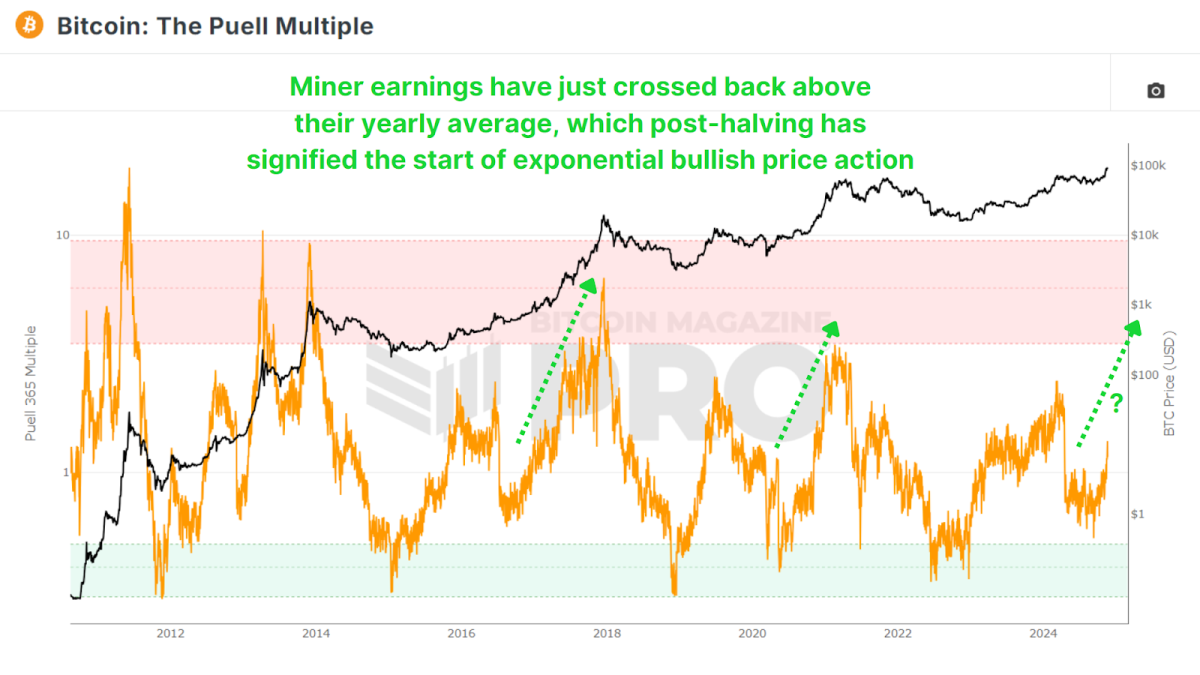
Yet even now, as Bitcoin has skyrocketed to new highs, the multiple indicates only a 30% increase in profitability relative to historical averages. This suggests that we are still in the early to middle stages of the bull market, and when comparing the patterns in the data we look like we have the potential for explosive growth akin to 2016 and 2020. With a post-halving reset, consolidation, and a finally a reclaim of the 1.00 multiple level signifying the exponential phase of price action.
Measuring Market Sentiment
The Net Unrealized Profit and Loss (NUPL) metric quantifies the network’s overall profitability, mapping sentiment across phases like optimism, belief, and euphoria. Similar to the MVRV Z-Score as it is derived from realized value or investor cost-basis, it looks at the current estimated profit or losses for all holders.
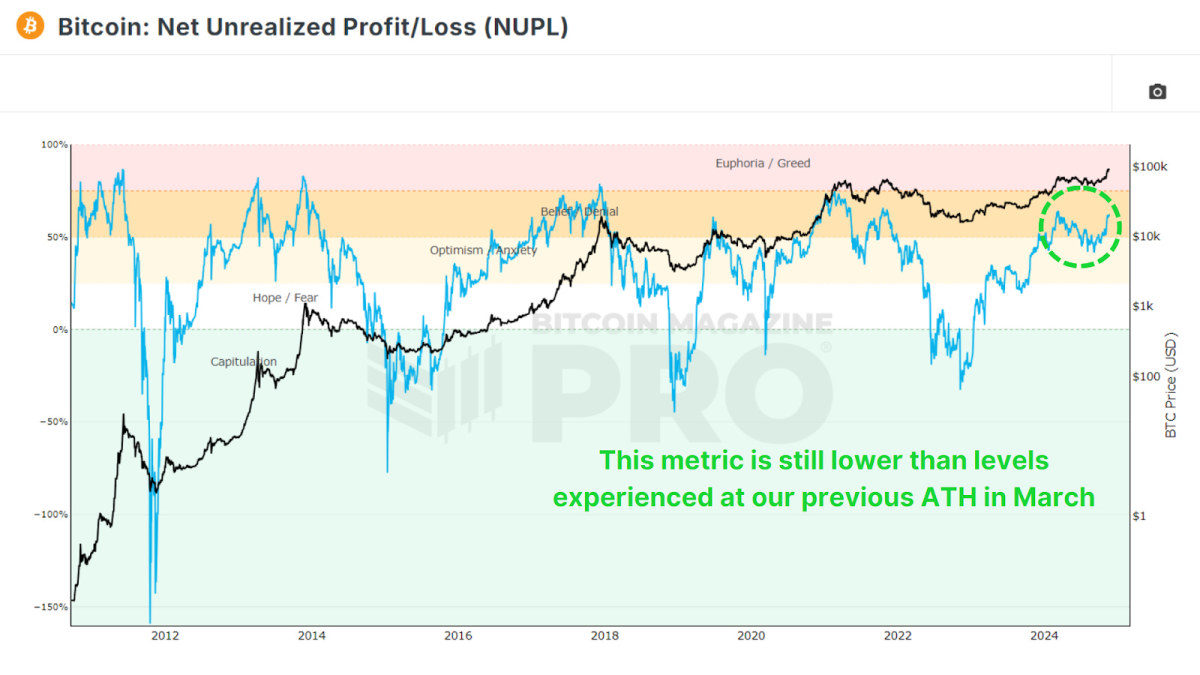
Presently, Bitcoin remains in the ‘Belief’ zone, far from ‘Euphoria’ or ‘Greed’. This aligns with other data suggesting there is ample room for price appreciation before reaching market saturation. Especially considering this metric is still at lower levels than this metric reached earlier this year in March when we set out previous all-time high.
Long-Term Holder Trends
The percentage of Bitcoin held for over a year, represented by the 1+ Year HODL Wave, remains exceptionally high at around 64%, which is still higher than at any other point in Bitcoin history prior to this cycle. Prior price peaks in 2017 and 2021 saw these values fall to 40% and 53%, respectively as long-term holders began to realize profits. If something similar were to occur during this cycle, then we still have millions of bitcoin to be transferred to new market participants.

So far, only around 800,000 BTC has been transferred from the Long Term Holder Supply to newer market participants during this cycle. In past cycles, up to 2–4 million BTC changed hands, highlighting that long-term holders have yet to cash out fully. This indicates a relatively nascent phase of the current bull run.
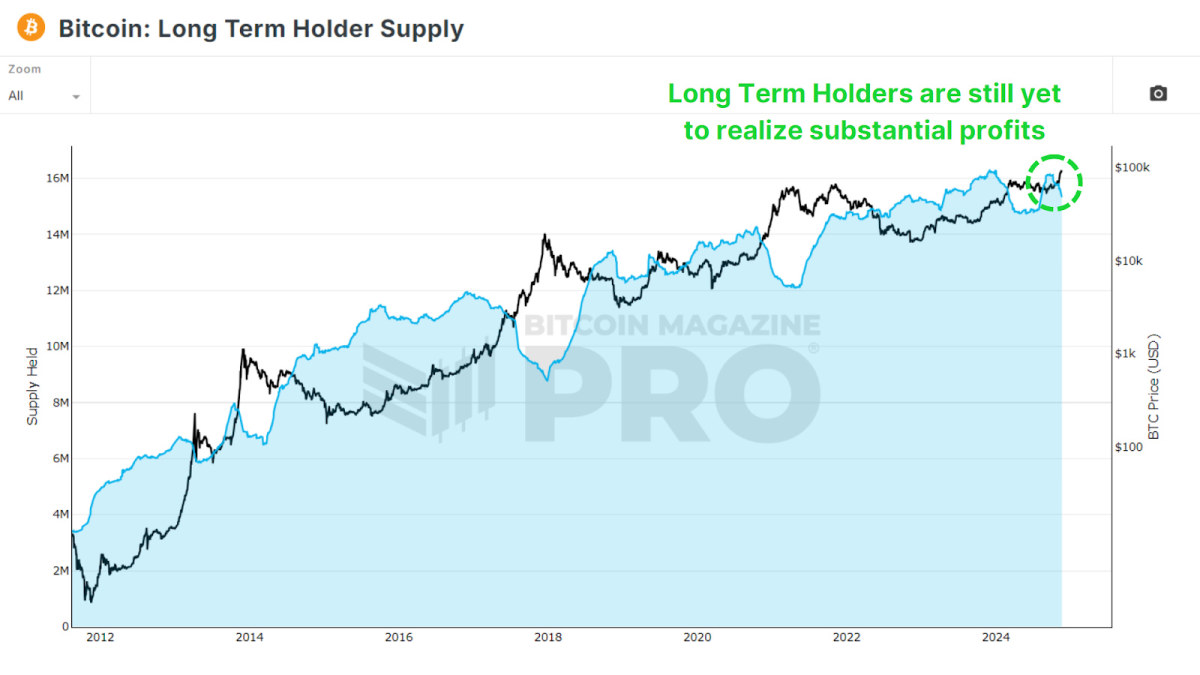
Tracking “Smart Money”
The Coin Days Destroyed metric weighs transactions by the holding duration of coins, emphasizing whale activity. We can then multiply that value by the BTC price at that point in time to see the Value Days Destroyed (VDD) Multiple. This gives us a clear insight into whether the largest and smartest BTC holders are beginning to realize profits in their positions.
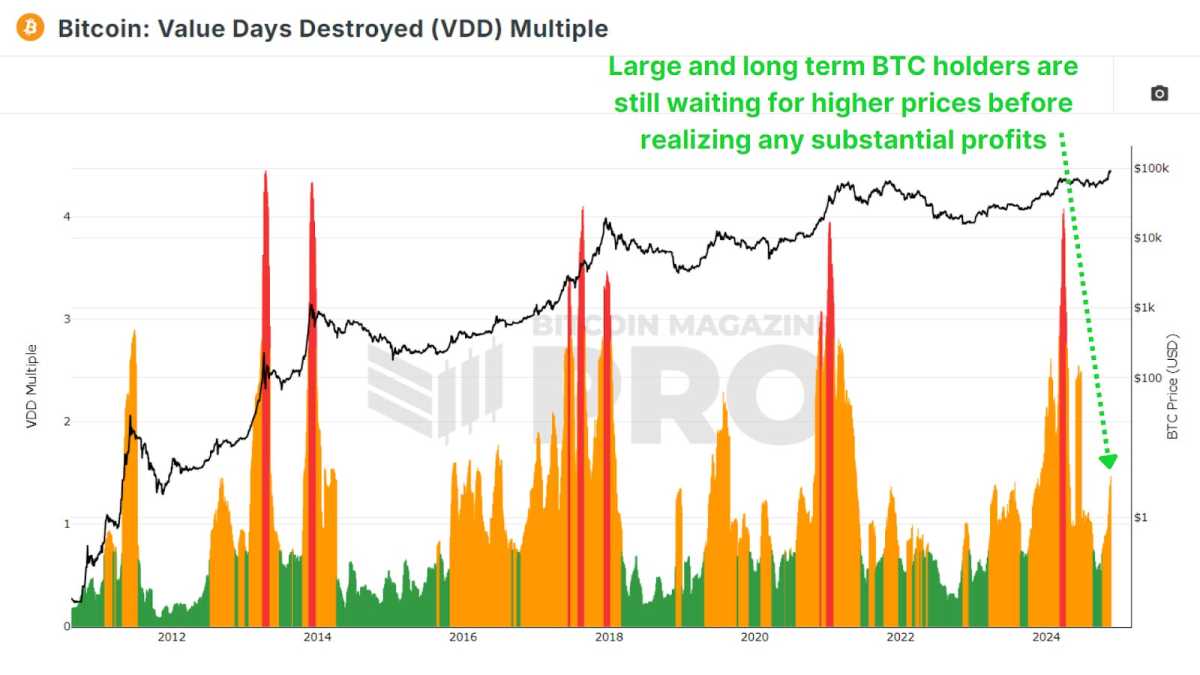
Current levels remain far from the red zones typically seen during market tops. This means whales and “smart money” are not yet offloading significant portions of their holdings and are still awaiting higher prices before beginning to realize substantial profits.
Conclusion
Despite the rally, on-chain metrics overwhelmingly suggest that Bitcoin is far from overheated. Long-term holders remain largely steadfast, and indicators like the MVRV Z-score, NUPL, and Puell Multiple all highlight room for growth. That said, some profit-taking and new market participants signal a transition into the mid to late-cycle phase, which could potentially be sustained for most of 2025.
For investors, the key takeaway is to remain data-driven. Emotional decisions fueled by FOMO and euphoria can be costly. Instead, follow the underlying data fueling Bitcoin and use tools like the metrics discussed above to guide your own investing and analysis.
For a more in-depth look into this topic, check out a recent YouTube video here: What’s Happening On-chain: Bitcoin Update
Source link

BTC and Major Altcoins Pullback, SAND Soars 60%

Трамп обирає менеджера прокрипто-хедж-фонду Скотта Бессента на посаду міністра фінансів

Trump calls up crypto pals, Senator says sell gold for Bitcoin | Weekly Recap

Where to Invest in November End?

XRP Price Hits 3-Year High At $1.6

Australia seeking advice on crypto taxation to OECD

Crypto Trader Records $2.5M Profit With This Token, Here’s All

Trump taps crypto bros to be in charge: What’s at stake?

Charles Schwab Looking at Spot Crypto Trading Following Regulation Shift: Report

Here’s Why XRP Price Will Hit $20

3 cryptos under $0.5 that experts believe could deliver 1500% returns

Gemini’s Cameron Winklevoss Demands Fresh Probe Into SBF

Dogecoin Jumps to 3-Year High Price—Before Bitcoin Cools and Meme Coins Plunge

Crypto cops record $8.2b in financial remedies for investors: SEC

Stellar Price Skyrockets Over 80%, XLM Rally to $1 Imminent?
182267361726451435

Why Did Trump Change His Mind on Bitcoin?

Top Crypto News Headlines of The Week

New U.S. president must bring clarity to crypto regulation, analyst says

Ethereum, Solana touch key levels as Bitcoin spikes

Bitcoin Open-Source Development Takes The Stage In Nashville

Will XRP Price Defend $0.5 Support If SEC Decides to Appeal?

Bitcoin 20% Surge In 3 Weeks Teases Record-Breaking Potential

Ethereum Crash A Buying Opportunity? This Whale Thinks So

Shiba Inu Price Slips 4% as 3500% Burn Rate Surge Fails to Halt Correction

‘Hamster Kombat’ Airdrop Delayed as Pre-Market Trading for Telegram Game Expands

Washington financial watchdog warns of scam involving fake crypto ‘professors’

Citigroup Executive Steps Down To Explore Crypto
Mostbet Güvenilir Mi – Casino Bonus 2024

Bitcoin flashes indicator that often precedes higher prices: CryptoQuant
Trending

 2 months ago
2 months ago182267361726451435

 Donald Trump4 months ago
Donald Trump4 months agoWhy Did Trump Change His Mind on Bitcoin?

 24/7 Cryptocurrency News3 months ago
24/7 Cryptocurrency News3 months agoTop Crypto News Headlines of The Week

 News3 months ago
News3 months agoNew U.S. president must bring clarity to crypto regulation, analyst says

 Bitcoin4 months ago
Bitcoin4 months agoEthereum, Solana touch key levels as Bitcoin spikes

 Opinion4 months ago
Opinion4 months agoBitcoin Open-Source Development Takes The Stage In Nashville

 Price analysis4 months ago
Price analysis4 months agoWill XRP Price Defend $0.5 Support If SEC Decides to Appeal?

 Bitcoin4 months ago
Bitcoin4 months agoBitcoin 20% Surge In 3 Weeks Teases Record-Breaking Potential


